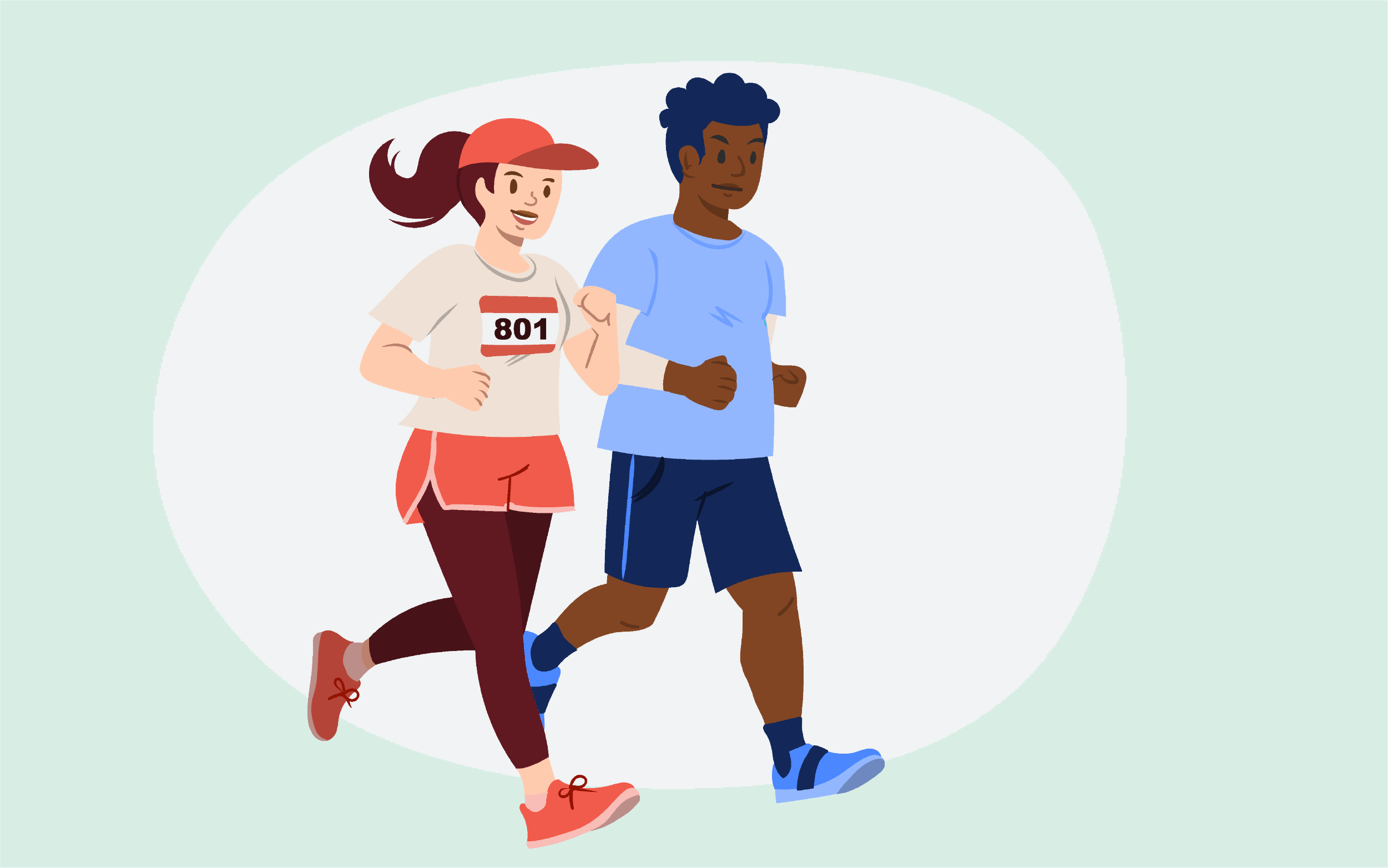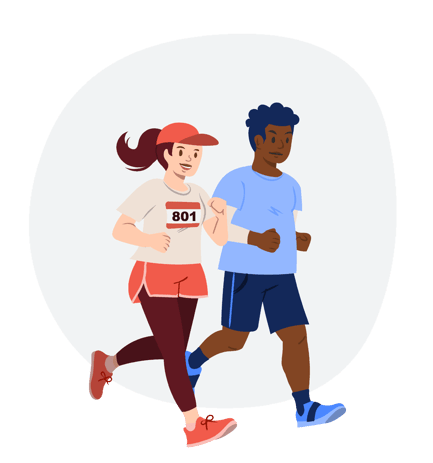There are a number of complexities and nuances to consider when conducting research with young people. Gen Z already has...
Meeting User Needs for Wellness and Fitness Digital Experiences

Posted by Jim Ross on Jun 6, 2023
Over the years, we've conducted many UX research studies for a range of health, exercise, and fitness digital experiences, from apps and websites to trackers and devices. Fitness and wellness can be a very personal experience, with wide ranges in why and how people want to utilize technology to better meet their goals. Across these projects, we've learned a great deal about people’s fitness goals, motivations and barriers to exercising, how they establish their routines, and the metrics they use to measure their progress.
In this article, we’re sharing our research-backed learnings and strategies for how health, wellness, and fitness brands can better support people’s goals across the following categories:
- Setting and Keeping Fitness Goals
- Acknowledging a Range of Motivations for Exercise
- Overcoming Barriers to Exercise
- Establishing Fitness Routines
- Tracking Fitness Metrics
Setting and Keeping Fitness Goals
Across our research, we have discovered that people’s health and fitness goals usually include one or more of the following:
- Losing weight or maintaining a healthy weight
- Fitting into clothes
- Looking better and more toned
- Remaining active and healthy
- Preventing the onset of health problems (heart problems, diabetes, etc.)
- Maintaining health, fitness, strength, and mobility while aging
- Healing from an injury or illness
- Training for a specific race or athletic event
- Improving mental health by boosting mood, easing anxiety, and relieving stress through exercise
Often, these fitness goals are intertwined with similar health goals of:
- Eating healthily
- Drinking enough water
- Getting adequate sleep
Ask users to select their fitness goals
When designing fitness experiences, make sure you give users a chance to select their fitness goals from a list of these common goals. Setting fitness goals can strengthen people’s commitment to exercise and remind them during difficult times why they are exercising and the benefits that they receive from it. Seeing a list of goals can remind users of the multiple benefits that they will be getting from their fitness habits. Across our studies, most participants were working toward multiple health goals, so allow them to choose multiple fitness goals.
Emphasize the mental health benefits of exercise
In our research, most people said they exercised for the mental health benefits, in addition to their physical health. Exercise helped them relieve stress, boost their mood, feel more energized, and feel positive about themselves. Reminding themselves of these positive feelings was their biggest motivator to stick with their exercise routines. So, be sure to emphasize the mental health benefits in the goals, and acknowledge mental health benefits in app notifications.
 Show fitness goals as ongoing goals and celebrate each step towards them as an achievement
Show fitness goals as ongoing goals and celebrate each step towards them as an achievement
All fitness goals are ongoing, instead of being something people achieve and then stop. Even reaching a target weight requires continual exercise and healthy eating to maintain. Each exercise session is a step towards being healthy and active. So, give people a sense of accomplishment and goal achievement with each time they exercise through acknowledgements and awards to celebrate them in their journey.
Acknowledging a Range of Motivations for Exercise
From our research, motivation to exercise came from the positive feelings that people got from exercising and seeing the tangible benefits, including:
- Feelings of accomplishment
- Feeling stronger, healthier, and more energetic
- Believing they were investing in their physical and mental health
- Observing tangible results from their exercise (losing weight, looking more toned, fitting in clothes better, receiving compliments from others)
- Experiencing the mental health benefits of exercising
- Thinking of the negative feelings they will experience if they don’t exercise
- Reminding themselves of their goals and the progress they are making towards them
Remind users of their fitness goals and their progress towards achieving them
Display users’ fitness goals as a reminder of what they are trying to achieve. Remind them of their progress towards those goals, to give them a feeling of accomplishment and to motivate them to keep working towards them. Use notifications to remind users of their progress and of the physical and mental benefits they are receiving from exercise.
Provide challenges as a fun motivation tactic
In our research, most people saw fitness challenges as a fun way to bring variety into exercise routines. Challenges motivated them by providing a feeling of accomplishment. Even small things, like earning a badge was perceived as enough of a reward for most participants.
Allow users to choose between solo or group challenges
Provide both solo challenges and group challenges. We have found that although most people like solo challenges, group challenges are hit or miss! Some people find them fun and motivating, while others find them discouraging. Provide group challenges as an option to accommodate those who like them, while keeping solo as the default.
Overcoming Barriers to Exercise
The main factors that prevented people from exercising included:
- Time constraints
- Inclement weather and seasonal changes
- Family obligations, such as childcare
- Lack of energy to leave home for the gym or a class
- The pressures of having to dress up and impress others at a gym or in a class
- Lack of self-discipline and motivation
- Boredom and monotony of exercise
- Major life changes disrupting routines
- Travel disrupting exercise schedules
- Injuries
Provide alternative exercises to overcome these barriers
In our studies, participants wanted suggestions of exercises and activities to overcome these barriers. Provide alternatives, such as shorter workouts, indoor exercises that can be performed at home, a wider variety of exercises to overcome monotony, and exercises to overcome specific injuries. By including a wide range of options, you’ll help your users overcome these challenges and stay engaged.
Emphasize activity in addition to exercise
Track and show the benefits of everyday activities, in addition to purposeful exercise. Showing steps taken, stairs climbed, calories burned, standing hours, and active minutes helps people realize that just being active provides benefits, even if they don’t have time to exercise each day.
Normalize missing exercise and having to start again
When life events cause people to miss their exercise routines, many find it difficult to pick up where they left off and to get motivated to begin exercising again. It is easy for them to become discouraged. Emphasize that breaks in routines are common and are nothing to be ashamed of. Make it easy for people to begin their routines again.
Establishing Fitness Routines
People choose fitness routines based on their interest and what feels comfortable and achievable. Many find the exercise that works best for them through trial and error. Some look for fitness routines online, such as watching YouTube videos or joining a subscription service. Others rely on recommendations from friends and family.
Allow people to choose the type of exercise that fits best with their needs
Since people vary so widely in their exercise goals, and current level of fitness, allow users to choose from a wide variety of fitness routines and exercises. For example, older adults trying to remain active have very different needs from runners training for an upcoming race. Participants in our studies were looking for routines that fit well with their body type and comfort. So, provide personalized, suggested routines to fit various interests based on user information and goals.
Make exercise enjoyable
Boredom and monotony were common exercise routine killers. People need exercise to be fun and enjoyable to motivate them to stick with it. Help people find an exercise routine that they enjoy. In our studies, some preferred outdoor exercise for the fresh air and scenery, many said music helped keep them motivated and entertained, some liked exercises that incorporated fun movements from dance, while others were motivated by engaging instructors.
 Provide solo and group exercise options
Provide solo and group exercise options
Some people prefer exercising alone, while others get motivation by exercising with others. Allow people to choose from solo or group exercise routines. Those who prefer solo exercise like having the time to themselves, exercising at their own pace, and being able to make mistakes or take breaks without fear of judgment. Those who like to exercise with others enjoy socializing with their fitness partners, feel more accountable to stick to their routines, and get motivation from their exercise partners.
Provide the ability to share fitness progress with others
Many of our participants found that sharing their progress with family and friends kept them accountable and motivated them to continue exercising. However, some were not comfortable with sharing this information. Even those who did want to share, wanted control over who to share their information with. So, make sharing optional and enable users to select who to share with, down to the individual.
Tracking Fitness Metrics
People often use fitness metrics to feel that they are making progress towards their goals. Depending on the type of experience, these could include high level stats like number of workouts per week, active time, and steps taken, or could get more specific with certain wearables like distance traveled, calories burned, and heart rate. Some fitness experiences may also classify certain workouts by difficulty level and track how users are progressing in their fitness levels.
Since wellness goals are ongoing and often long-term, metrics give users a way to concretely track how they’re doing. They can also provide trends over time, showing users their progress and suggestions to adjust behaviors going forward.
Display only a few key metrics on screen during workouts
While exercising, most people only look at their metrics occasionally, keeping their focus primarily on the workout itself. When you’re displaying metrics on a tracker or just on a user’s phone during a workout, we recommend sticking to just the top metrics during a workout and showing them with large fonts and recognizable icons to keep it easy to interpret. These metrics could include time elapsed, distance traveled, or heart rate depending on the type of device or app you’re building. Users typically want to see their metrics at a quick glance, without having to interact with their phone or tracker which some felt could be distracting or dangerous.
Save the detailed view for after a workout and on a bigger screen
When people want to see more details about their workouts, they prefer to view that information on smartphone fitness apps, instead of wearables. Many feel it’s easier to navigate and view more detailed information on a larger phone screen, and of course, post-workout, when they can really dig into the stats.
Focus on metrics that can be automatically monitored without user input
Most people prefer to keep track of metrics that are automatically collected and monitored, like steps taken, active time, or sleep hours. They do not like to take the time to enter data that needs to be manually entered, such as water intake, mood, or stress levels. Even those who try to take the time to enter that information often forget to do it consistently. Instead, it is better for devices and apps to focus on automatically tracking as much as possible.
Provide guidance about how to interpret and use the fitness metrics
Although most people review the basic metrics, we have found that many do not know how to interpret their metrics or what to do about them. Fitness apps should help users understand their metrics and how to use them to improve their fitness routines. Participants in our studies wanted a fitness app that would use their data to anticipate their needs and guide them with proactive suggestions.
...
Following these best practices will help you design effective fitness digital experiences, but it’s always important to evaluate the usability and usefulness of your designs by conducting UX research and usability testing with people to understand their fitness needs.
Jim Ross
Jim Ross is a Principal UX Researcher at AnswerLab where he leads research with clients to help them better understand their customers, in order to create experiences that people love. He has over 20 years of experience in UX research and design, is a frequent speaker at UX conferences, and is a prolific author for UX magazines and blogs.related insights
Get the insights newsletter
Unlock business growth with insights from our monthly newsletter. Join an exclusive community of UX, CX, and Product leaders who leverage actionable resources to create impactful brand experiences.